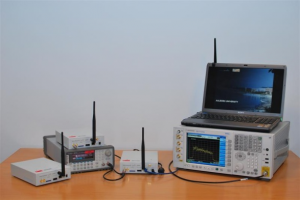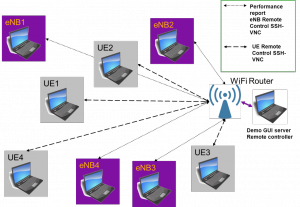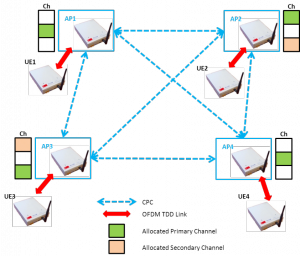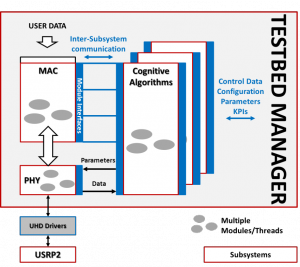The Aalborg University testbed is an experimental platform aiming to provide support for the Proof-Of-Concept of cognitive radio algorithms; specifically considering a femtocell deployment scenario. The purpose of the testbed is mainly to provide qualitative results which can improve the research over cognitive radio concepts.
The software platform pursues a modular, component-based and flexible architecture able to ensure re-usability of the implemented features and extensive control over the testbed configuration settings.
The research activities carried on with the testbed are related to the implementation and experimentation of algorithms for the cooperative Dynamic Spectrum Allocation. In particular the implementation of features related to the Autonomous Component Carrier Selection in a LTE-inspired network have been the main focus.
The platform allows implementing specific algorithmic functionalities as independent modules that can be connected with other modules in order to create a complete communication system. The platform allows defining and setting all the configuration parameters through XML configuration files. The testbed features control channel capabilities and also offers a WiFi-based backhaul network that can be used for control data exchange, synchronization and coordination among the nodes. The backhaul connection can also be used for control ling the execution of the nodes and collect system information data.
A general idea of the organization of the Aalborg University Testbed is provided in Figure 2: nodes in the network can act as eNB/Acces Points or UEs, in a “LTE-inspired” network. Network control is provided by the backhaul WiFi connection and a server.
Figure 3 shows a typical configuration of the testbed, highlighting critical features such as the OFDM-based link connections, the channel resources organized in multiple Component Carriers and the Control Channel
Figure 4 provides an insight on the platform software architecture: the system is organized in subsystems which implement specific communication activities (PHY layer, MAC, Cognitive Engine and others). Each subsystem is organized in sub-modules that perform specific low-level processing tasks. System components such as modules and subsystem can be connected in a flexible manner, and their execution can be managed over multiple threds. The so defined system, runs as a process in the OS user-space of the host computers, and is able to interface with the SDR hardware through the Ettus Universal Hardware Drivers (UHD).
All the developed software has been written in C++. The platform exploits the Poco C++ libraries which provide support with TCP network connections, multiple threads synchronization and shared memory management. Support for the communication processing tasks is provided by the IT++ library while the Google Test environment is extensively used in the framework of a Test-Driven Development (TDD) of the code. As previously mentioned the UHD drivers, which can also be used as C++ libraries, provide interfacing support with the SDR hardware. The platform runs in Linux OS environment.
At present time the software platform code has not been released and is protected; however suitable licensing will be adopted in the future, targeting an open source release of the code.
The main hardware components are the Ettus Research Universal Software Radio Peripheral (USRP) in its 2 and N200 versions. The Radio Frequency front end is provided by the Ettus Research XCVR2450 daughterboards capable of operating at 2.4 and 5 GHz.
Other details
- At the present all the communication features of the nodes in the system run on the host PCs; Linux OS and the aforementioned C++ libraries are required. In order to ensure proper execution of the processing tasks we recommend the usage of multiple cores, last generation CPUs (i.e. Intel Core I7).
- Dual band 2.4 – 5 GHz, omni-directional antennas are used. WiFi capabilities are required at the host PCs.
- The system can be configured to operate in the 2.4 or 5 GHz band.
- The current development with the Aalborg University Testbed does not target any specific CR standard.
- Pilot-based power measurements are performed.
- The system capabilities are inspired by the LTE standard, but the testbed is not meant to be standard compliant.
- The Aalborg University platform has been initially developed within the EU FP7 project SAMURAI (http://www.ict-samurai.eu/). The cognitive features of the testbed have been implemented in tight cooperation with Nokia Siemens Denmark, which provided consultancy.
- The development of the platform is aiming at improving the quality of the implemented features and in particular at expanding the set of cognitive and RRM algorithms. A second key area for future improvements is related to increasing the PHY layer performance by exploiting FPGA-based processing and implementing advanced spectrum sculpting and base-band processing features.
- The flexibility of the platform can be exploited for cross-platform algorithms testing purposes, and research over inter-system coexistence.




